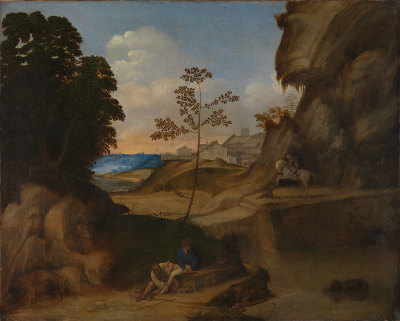Last night we attended the private view of In the Age of Giorgione at the Royal Academy. President Christopher Le Brun opened the show with a speech referring to Giorgione’s elusiveness, and his immense influence on subsequent artists, all the more remarkable considering the short span of his life (he died aged 32). Wandering round the exhibition, I couldn’t help thinking that the trouble with showing Giorgione with his contemporaries is that all other paintings, even by great masters like Titian and Bellini, seem almost crude in comparison. He shares that quality with Leonardo da Vinci. In his portraits his subjects shine with a clear light through a wonderful sfumato, unlike others whose smokiness can end by blurring the subject. His subjects seem infused with a living quality, reflective, even melancholic. Even his warrior is dreamy, the light shining gently off his armour, as he gazes off into the distance. And his archer recedes half seen into a twilight background. Giorgione’s paintings are not showy, they are almost understated, yet they strike vividly and remain in the mind’s eye. His beautiful landscapes foreshadow Claude Lorraine, with small figures enigmatically occupied and dwarfed by immense perspectives receding into the blue distance. Here his extraordinary mysterious Il Tramonto is included, which we are so fortunate to be able to see whenever we want at the National Gallery. In Madonna and Child in a Landscape, a moving small painting, the madonna holds her baby’s head with a tender hand, and the child himself muses with a gentle resignation on what he knows the future has in store for him. And as for the stark disturbing beauty of La Vecchia, we have to wait for Rembrandt to even come close to that honest look at the rigours of age without caricature, without sentimentality. As Giorgione painted so few works this is a rare opportunity to spend some time in the company of a great spirit and a great master.
